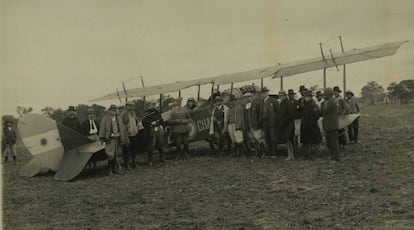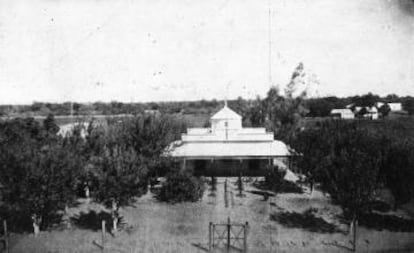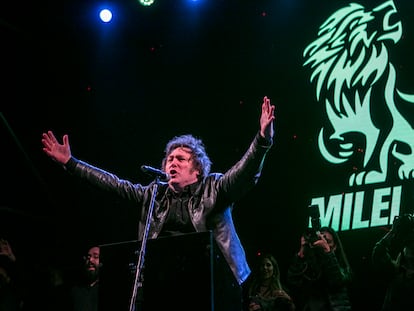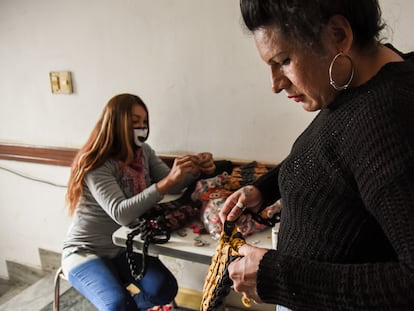Will the 500 indigenous people killed in the 1924 Napalpí massacre finally see justice?
A trial to establish the truth over what happened on the Argentine mission began this week, led by the testimony of its remaining survivor


Rosa Grilo is more than 100 years old. She doesn’t know exactly how old, but she remembers that she was a little girl on July 19, 1924. She also remembers the noise of the plane that flew low and threw candy from the air, and that when her people ran after it they were shot with a machine gun.
“They thought it was goods,” things they could use, she says. “My grandfather said: ‘Don’t go,’ that plane is carrying the bomb, we must run away.”
But “the people went to get the goods, and when they were all together they dropped the bomb,” she recalls.
Her grandfather’s precautions saved Grilo. She is the last survivor of the Napalpí massacre, a manhunt that ended with 500 indigenous Qom and Moqoit people shot and hacked to death.
Grilo, a Qom woman, lives with her children in a rural area of the province of Chaco, in northern Argentina. Her voice was heard on a recording this Tuesday at the beginning of an unprecedented trial in Latin America, which aims to shed light on what happened in Napalpí, a municipality of Chaco where indigenous people were confined to a mission, known in Argentina as reducciónes.
There will be no criminal consequences, as none of the policemen, landowners, or politicians responsible are alive. But the trial will establish a new official history and bury the one still in force, which says that the deaths in Napalpí were the result of a confrontation between the Qom and Moqoit.
The truth is that the story of the Napalpí massacre begins with the revolt of hundreds of indigenous people who refused to continue working in mission cotton plantations for a salary paid in clothes and food vouchers.
Survivors, who, like Rosa, had hidden with their families in the bushes, were persecuted for months following the massacre.

In a letter sent to Congress, Enrique Lynch Arribálzaga, ex-director of the mission wrote: “The slaughter of Indians by the Chaco police continues in Napalpí and its surroundings. It seems that the criminals planned to eliminate all those who were present in the carnage of July 19 [...], so that they could not serve as witnesses.”
The survivors hid in the bushes while the landowners in the area celebrated what they considered a successful act of pacification. When they emerged later, the survivors never spoke of what happened.
Qom historian Juan Chico created the Napalpí Foundation 15 years ago, with the aim of recovering the truth about the massacre. Chico knocked on the doors of dozens of officials and traveled through the Chaco region looking for survivors. He found five, among them Rosa Grilo, as well as Pedro Valquinta, a Moqoit man who died in 2015 at the age of 108.
From a video recorded in 2012, the court on Tuesday heard Vaquinta’s testimony:
“I am 105 years old, I don’t remember what year it was, I was 12 or 10 years old. There were many new rich people who were cutting down the forest. And the Mocovíes [Moqoit people] were being killed. And there they shot them. Mocovíes came to work and they were killed there, they [the killers] were sent by the police,” he says in a video recorded in 2012.
Sadly, Juan Chico died last year, a victim of Covid-19.
Prosecutor Diego Vigay took up the case and obtained official support for a trial to establish the truth of the massacre. Vigay says, “the victims have the right to the truth,” as has been established by the Inter-American Court of Human Rights regarding crimes against humanity. The trial is also a contribution to ensuring such a crime is not repeated, including by imposing symbolic reparation measures on the perpetrators, adds the prosecutor.
Starting this Monday, some 50 witnesses, including survivors, family members and investigators, will appear before the Chaco court.
Photos taken before the massacre by the German ethnologist Robert Lehmann-Nitsche, are a crucial tranche of evidence. It is in this archive that the image of the plane described by Rosa Grilo was discovered.
In describing the photograph, “Lehmann-Nitsche writes ‘airplane against indigenous uprising’ in German,” explains Mariana Giordano, historian and senior researcher at the National Council for Scientific and Technical Research, in an interview with EL PAÍS. Other photos show indigenous people with a white handkerchief knotted on their arm, a sign that “they were one of the good guys.”

Today, the site of the 1924 massacre is called Colonia Aborigen. Everyone knows that the dead are buried in a mass grave there. The Argentine Forensic Anthropology Team (EAAS) worked for a month in the area. They did not locate the grave, but they did find the remains of a man around 40 years old with a wounded foot.
“He would have been one of those who tried to escape and then died near the massacre,” Vigay says.
“He was buried less than 30 centimeters deep,” continues the prosecutor, adding that this coincides with the well-known story that those who died in the massacre were immediately buried on the site, not far from the surface. Meanwhile, the experts are not giving up hope on finding the mass grave.
The Napalpí Foundation’s David García says he trusts that the trial will help Argentine society to know the historical significance of the massacre, creating an opportunity for increased understanding between indigenous and racially mixed people in the country. The new young generation, he notes, has “different expectations and other points of view” than the previous generations.
Depending on her health, Rosa Grilo will appear in person at the trial and give further testimony. As she has recounted dozens of times, she will tell the audience about the plane, the explosions, the flight to the bushes with her grandfather and the silence she kept about what she lived through.
“I am not lying”, says Grilo simply. “What happened, happened.”
Tu suscripción se está usando en otro dispositivo
¿Quieres añadir otro usuario a tu suscripción?
Si continúas leyendo en este dispositivo, no se podrá leer en el otro.
FlechaTu suscripción se está usando en otro dispositivo y solo puedes acceder a EL PAÍS desde un dispositivo a la vez.
Si quieres compartir tu cuenta, cambia tu suscripción a la modalidad Premium, así podrás añadir otro usuario. Cada uno accederá con su propia cuenta de email, lo que os permitirá personalizar vuestra experiencia en EL PAÍS.
¿Tienes una suscripción de empresa? Accede aquí para contratar más cuentas.
En el caso de no saber quién está usando tu cuenta, te recomendamos cambiar tu contraseña aquí.
Si decides continuar compartiendo tu cuenta, este mensaje se mostrará en tu dispositivo y en el de la otra persona que está usando tu cuenta de forma indefinida, afectando a tu experiencia de lectura. Puedes consultar aquí los términos y condiciones de la suscripción digital.
More information
Últimas noticias
Most viewed
- Sinaloa Cartel war is taking its toll on Los Chapitos
- Oona Chaplin: ‘I told James Cameron that I was living in a treehouse and starting a permaculture project with a friend’
- Reinhard Genzel, Nobel laureate in physics: ‘One-minute videos will never give you the truth’
- Why the price of coffee has skyrocketed: from Brazilian plantations to specialty coffee houses
- Silver prices are going crazy: This is what’s fueling the rally










































